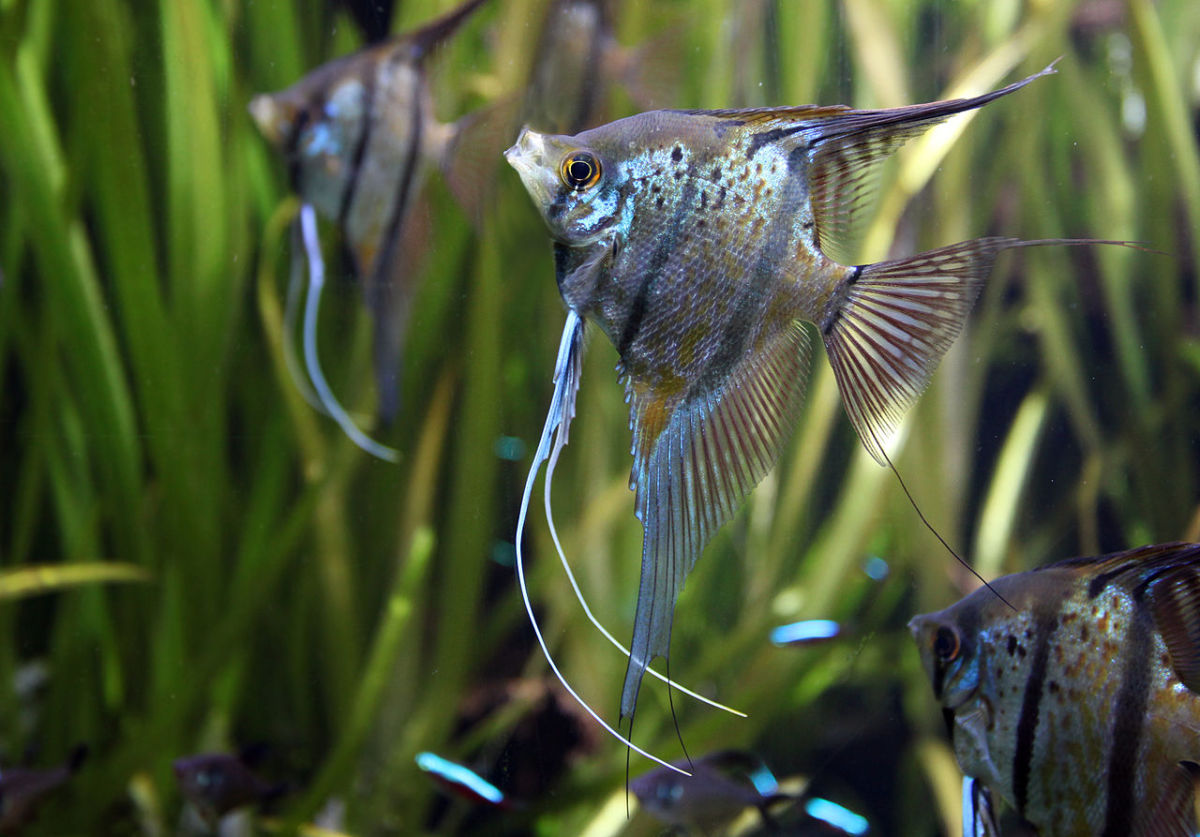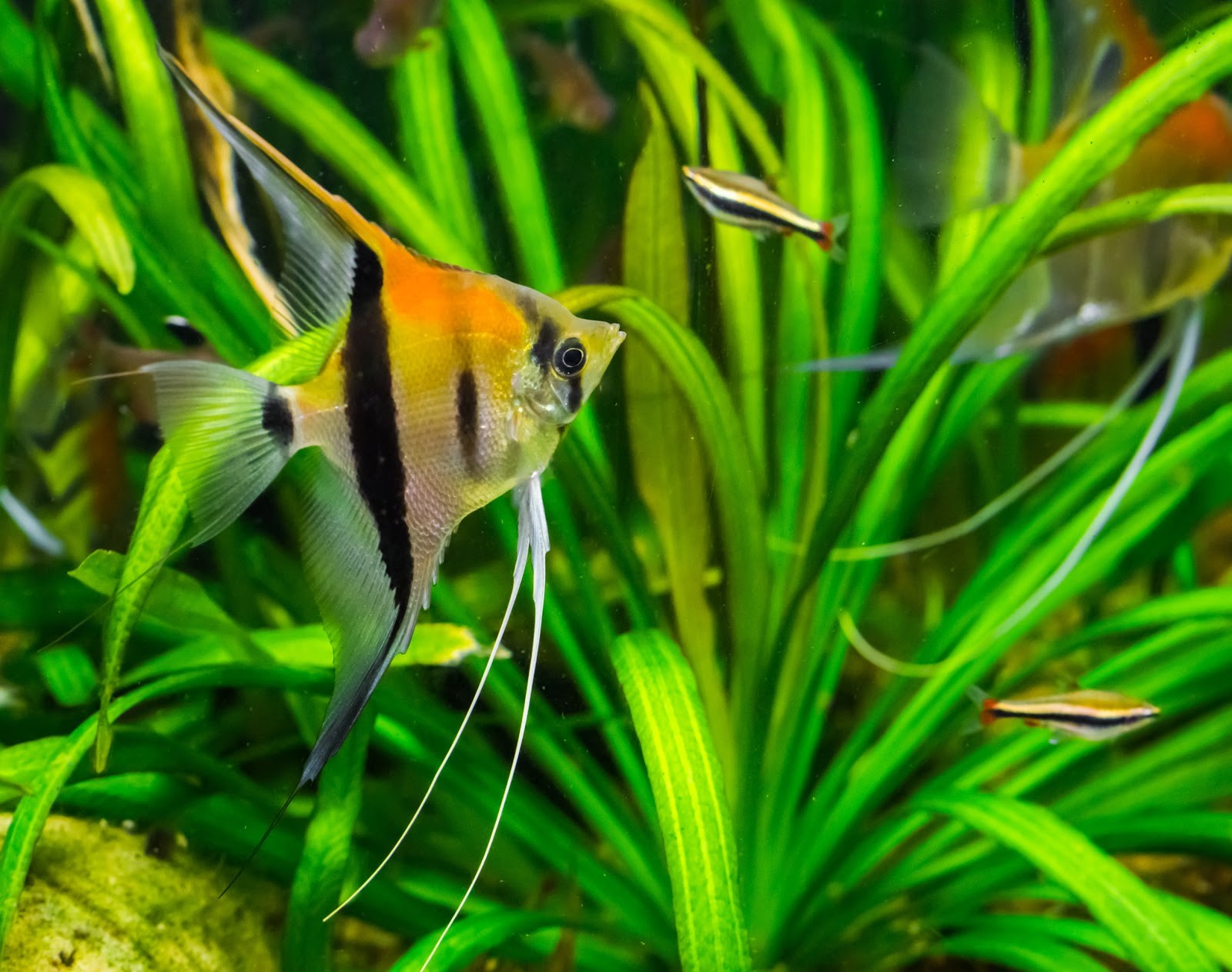Tetras can live with angelfish, but tank conditions and fish species must be carefully managed. Compatibility depends on factors like tank size and temperament.
Tetras and angelfish can coexist in a community tank, creating a visually appealing aquarium. Both species require similar water conditions, making them potential tank mates. Ensure the tank is spacious enough to prevent territorial disputes. Choose peaceful tetra species like neon or cardinal tetras to avoid aggression.
A well-planted tank with hiding spots helps reduce stress. Monitor their behavior closely to ensure harmony. Regular water changes and maintaining proper parameters support their health. By carefully selecting tank mates and providing an optimal environment, you can enjoy a vibrant and peaceful aquarium.
Introduction To Tetras And Angelfish
Tetras and Angelfish are popular aquarium species. They are known for their vibrant colors and unique behaviors. Many hobbyists wonder if these two can live together in harmony. Understanding their characteristics can help answer this question.
Tetra Species Overview
Tetras are small, colorful fish. They are native to South America. They prefer to live in schools. Below are some common types of Tetras:
- Neon Tetras: Bright blue and red stripes.
- Cardinal Tetras: Similar to Neon Tetras but larger.
- Black Skirt Tetras: Black and silver bodies with long fins.
- Rummy Nose Tetras: Red nose and striped tail.
| Tetra Species | Size | Color |
|---|---|---|
| Neon Tetra | 1.5 inches | Blue and Red |
| Cardinal Tetra | 2 inches | Blue and Red |
| Black Skirt Tetra | 2 inches | Black and Silver |
| Rummy Nose Tetra | 2 inches | Red and Silver |
Angelfish Characteristics
Angelfish are elegant and graceful. They have long, flowing fins. These fish are native to the Amazon Basin. Angelfish have unique behaviors and needs:
- Size: Up to 6 inches long.
- Temperament: Semi-aggressive, territorial.
- Diet: Omnivorous, enjoys a variety of foods.
- Environment: Prefers warm, slightly acidic water.
Angelfish can be very territorial. They need ample space to swim. They may nip at smaller, slower fish.

Credit: aquariumlabs.water.blog
Natural Habitats
Understanding the natural habitats of both tetras and angelfish is crucial. This helps determine if they can coexist in a tank. Both species come from unique environments. These environments influence their behavior and compatibility.
Tetra Habitats
Tetras originate from the Amazon River Basin. They thrive in slow-moving waters. These waters are often shaded by dense vegetation. Tetras prefer a habitat with plenty of plants. This provides them with hiding spots. The water is usually soft and slightly acidic. The temperature ranges from 72°F to 82°F.
Here’s a quick overview of their habitat preferences:
| Feature | Details |
|---|---|
| Water Type | Soft and acidic |
| Temperature | 72°F to 82°F |
| Environment | Vegetation and hiding spots |
Angelfish Environments
Angelfish also come from the Amazon River Basin. They are found in slow-moving waters. These waters are often warm and slightly acidic. Angelfish prefer tall plants and submerged roots. These provide shelter and breeding sites. The water temperature ranges from 75°F to 86°F.
Below is a summary of their habitat needs:
| Feature | Details |
|---|---|
| Water Type | Soft and slightly acidic |
| Temperature | 75°F to 86°F |
| Environment | Tall plants and roots |
Behavioral Differences
Understanding the behavioral differences between tetras and angelfish is crucial for a harmonious aquarium. Their temperaments and social behaviors can impact the tank environment.
Tetra Temperament
Tetras are known for their peaceful nature. They thrive in groups and exhibit schooling behavior. This means they swim together, creating a beautiful display. Tetras are active swimmers and enjoy open spaces in the tank. They can get stressed if kept alone or in small numbers.
| Tetra Behavior | Details |
|---|---|
| Peaceful | Non-aggressive towards other fish. |
| Schooling | Prefer to stay in groups. |
| Active Swimmers | Love to swim in open areas. |
Angelfish Behavior
Angelfish have a more territorial nature. They can display aggressive behaviors, especially during breeding. Angelfish prefer vertical swimming spaces and can be defensive of their territory. They are also known to nip at the fins of other fish.
- Territorial: Defend their space in the tank.
- Aggressive: Can be hostile during breeding.
- Vertical Swimmers: Prefer tall tanks with vertical space.
- Fin Nipping: May nip at other fish’s fins.
Aquarium Setup Requirements
Setting up an aquarium for both tetras and angelfish requires careful planning. Both species have specific needs to thrive together. This section will guide you through the essential setup requirements.
Tank Size Considerations
The tank size is crucial for a harmonious environment. Angelfish grow larger than tetras and need more space. A minimum of 30 gallons is recommended. This allows enough room for both species to swim freely.
Consider the number of fish you plan to keep. More fish will need a larger tank. Overcrowding can lead to stress and aggression.
Optimal Water Conditions
Both tetras and angelfish thrive in similar water conditions. Keeping the water parameters stable is key. Here are the optimal conditions:
- Temperature: 75-82°F (24-28°C)
- pH level: 6.5-7.5
- Hardness: 3-8 dKH
Regular water changes are essential to maintain water quality. Aim for a 25% water change every week.
Use a reliable filter to keep the water clean and clear. Proper filtration reduces harmful substances and keeps your fish healthy.
Additional Tips
Providing hiding spots can reduce stress for tetras. Plants and decorations create a natural environment. Ensure there is enough space for angelfish to swim freely.
Monitor fish behavior regularly. Watch for signs of stress or aggression. Adjust the tank setup if needed to ensure a peaceful coexistence.
Feeding Habits
Understanding the feeding habits of both tetras and angelfish is crucial for maintaining a harmonious aquarium. Each species has unique dietary needs that must be met to ensure their health and well-being. Let’s delve into the specific diets of tetras and angelfish.
Tetra Diet
Tetras are omnivores. They thrive on a varied diet. Here are some key components of a tetra diet:
- Flake Food: High-quality flake food forms the base of their diet.
- Freeze-Dried Foods: Bloodworms, brine shrimp, and daphnia are excellent choices.
- Fresh Vegetables: Small pieces of spinach or lettuce can be offered occasionally.
- Live Foods: They enjoy live brine shrimp and micro-worms.
It’s important to feed tetras multiple times a day. They have small stomachs and frequent meals ensure they get enough nutrition.
Angelfish Nutrition
Angelfish are also omnivores but require a slightly different diet. Here are the primary elements of an angelfish diet:
- Pellets: High-quality angelfish pellets provide balanced nutrition.
- Frozen Foods: Bloodworms, brine shrimp, and mysis shrimp are favored.
- Live Foods: Occasional live food like guppies or small insects.
- Vegetables: Blanched peas or zucchini can be given as treats.
Angelfish should be fed once or twice daily. Overfeeding can lead to health problems.
| Food Type | Tetra | Angelfish |
|---|---|---|
| Flake Food | Yes | No |
| Pellets | Yes | Yes |
| Freeze-Dried Foods | Yes | Yes |
| Fresh Vegetables | Occasionally | Occasionally |
| Live Foods | Yes | Yes |
Feeding tetras and angelfish properly ensures they stay healthy and vibrant. Both species benefit from a mix of protein and plant-based foods. Always observe your fish to ensure they are eating well and adjust their diet as needed.

Credit: pethelpful.com
Compatibility Factors
Understanding the compatibility factors between Tetras and Angelfish is crucial. Both species have unique needs and behaviors. Ensuring a harmonious tank environment is key for their well-being.
Aggression Levels
Angelfish can be aggressive, especially during breeding times. They might chase or nip at smaller fish. Tetras, on the other hand, are generally peaceful. But, they can get stressed if constantly harassed.
To reduce aggression, make sure your tank has plenty of hiding spots. Use plants, rocks, and decorations to create safe spaces. This way, Tetras can escape if an Angelfish gets too aggressive.
Schooling Vs. Solitary
Tetras are schooling fish. They thrive in groups of six or more. This behavior makes them feel safe and reduces stress. Angelfish prefer a more solitary or pair-oriented existence.
When setting up your tank, keep this in mind. Ensure there are enough Tetras to form a school. This helps balance the tank dynamics.
| Factor | Angelfish | Tetras |
|---|---|---|
| Aggression | High during breeding | Low |
| Social Behavior | Solitary or pairs | Schooling |
| Tank Requirements | Large spaces | Groups |
By understanding these compatibility factors, you can create a peaceful tank. Both species can thrive together with the right setup.
Successful Co-habitation Tips
Many aquarium enthusiasts wonder if tetras can live with angelfish. It is possible, but it requires careful planning and monitoring. This section provides tips to help your tetras and angelfish live together peacefully.
Introducing New Fish
Introducing new fish to your tank is a delicate process. Follow these steps to ensure a smooth transition:
- Quarantine the new fish for at least two weeks.
- Acclimate the new fish to the tank water slowly.
- Release the new fish during feeding time to minimize aggression.
Monitoring Interactions
Keep a close watch on the interactions between tetras and angelfish. This will help you identify any signs of stress or aggression:
- Observe the fish during feeding times.
- Check for any signs of fin nipping or chasing.
- Ensure that both species have enough space to swim.
| Observation | Action |
|---|---|
| Fin nipping | Increase hiding spots |
| Chasing | Rearrange tank decorations |
| Stress signs | Check water parameters |
By following these tips, you can help your tetras and angelfish live together peacefully. Remember, patience and careful observation are key to successful co-habitation.
Common Issues And Solutions
Keeping Tetras and Angelfish together can be challenging. These challenges can lead to stress and conflicts. Here, we discuss common issues and solutions.
Signs Of Stress
Fish can show stress in various ways. It’s crucial to recognize these signs early.
- Color Fading: Stressed fish may lose their bright colors.
- Erratic Swimming: Swimming in circles or darting around is a stress sign.
- Hiding: Fish may hide more often if stressed.
- Loss of Appetite: Stressed fish often refuse food.
Preventing Conflicts
Preventing conflicts between Tetras and Angelfish requires planning. Follow these steps for a peaceful tank.
- Tank Size: Ensure the tank is large enough. A 30-gallon tank is ideal.
- Hiding Spots: Add plants and decorations. This gives fish places to hide.
- Feeding: Feed fish separately to avoid competition.
- Temperament: Choose calm Tetra species. This reduces the risk of conflicts.
- Monitoring: Regularly check fish behavior. Separate aggressive fish if needed.
Following these steps can help maintain harmony in your tank.

Credit: fantaseaaquariums.com
Conclusion
Tetras and Angelfish can coexist with proper care and attention. Ensure the tank is spacious and well-maintained. Monitor their behavior to prevent aggression. Choosing compatible species and providing hiding spots can enhance harmony. With the right conditions, these fish can thrive together, creating a vibrant and peaceful aquarium environment.
